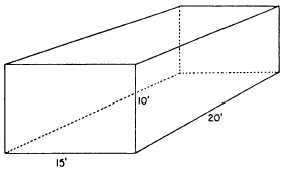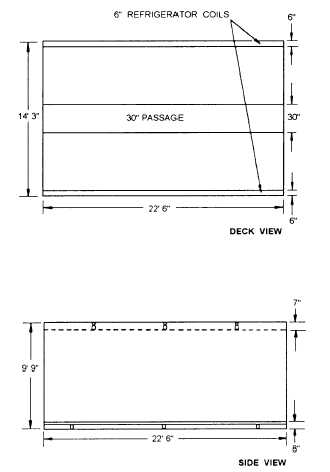| |
requirement for milk for 1,000 personnel for 30 days is
1,063 cubic feet; however, this is based on milk being
delivered daily except on Sunday. For example, the
storage requirement for a 20-day supply of milk is
20/30ths of 1,063, or 709 cubic feet. Adjust storage data
when requisitioning frozen meats instead of chilled
sausage meats and other cured meats. Chilled storage is
recommended for fresh potatoes and onions. If you have
separate specific storage areas for these items, adjust the
chill storage requirements accordingly. Storage
requirements reflect only the space required for the
foods in their packaging. You should estimate the
additional space required for air circulation, aisles,
shelves, and battens. The many variations in storage
space configuration make a standard modification
impractical.
The 45-day SEB and the 6-month requirement for
spices and low-use staple items for afloat GMs are
contained in NAVSUP P-486, volume I, appendixes D
and E, respectively. They serve as guides in planning
readiness requirements for those ships with prescribed
endurances that extend beyond 30 days. The SEB
includes a larger portion of dehydrated and other
spacesaving items and a smaller portion of refrigerated
items than is generally used when operating conditions
permit regularly scheduled replenishment of more bulky
perishable items. When these endurance base guides are
used in combination with 30-to 45-day stock levels that
reflect an individual ship’s normal usage, endurance
levels can be adapted to the storage space limitation of
the ship.
Procurement Restrictions
Food items authorized for Navy use are listed in the
FSC. Requests for exceptions or deviations from usage
restrictions should be submitted via the chain of
command to NAVFSSO with complete justification.
Brand name items are not authorized. Check the
NAVSUP P-486, volume I, for further information about
procurement restrictions.
Private messes have the option to use either the
Navy supply system or commercial vendors, or both.
Determining Space Availability
Now that you know how to estimate quantities, you
should learn to estimate storage space. You do not want
to order more than can be stored.
The capacity of a compartment shaped like the one
shown in figure 12-4 is found by multiplying the length
by the width by the height; for example, 20 x 15 x 10=
3,000 cubic feet.
12-7
Figure 12-4.–Rectangular space.
Unfortunately, all storage spaces are not this easy to
figure. Many times there are coils, pipes, lights, and
required passageways or aisles that prevent you from
using all the space. You cannot pack or store food items
up to the overhead or from bulkhead to bulkhead
because room for ventilation and access to the food
items must be provided.
For example, a storage space 22 feet 6 inches long,
14 feet 3 inches wide, and 9 feet 9 inches high is shown
in figure 12-5. There are coils extending out 6 inches
Figure 12-5.-Space with obstructions.
|


